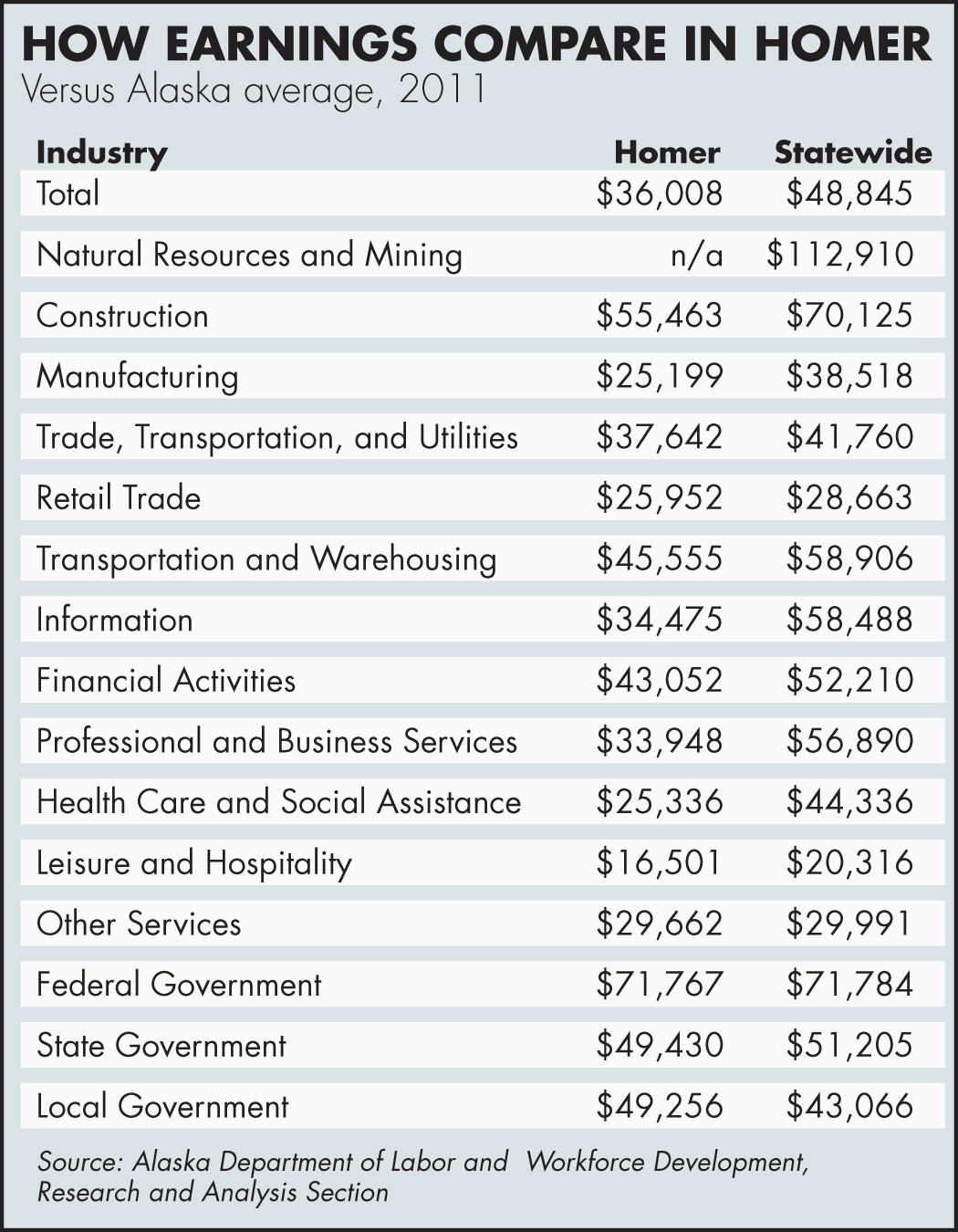Most of us living here in the Cosmic Hamlet by the Sea have always suspected that we are, well, a little different. Turns out state labor analysts agree.
Writing in the latest issue of Alaska Economic Trends, Economist Alyssa Shanks, of the Alaska Department of Labor, confirmed what a simple look around would lead you to believe about Homer.
“Despite some similarities to the rest of the state, Homer has key differences in industry make-up, income and demographics,” she said.
We are, she said, quite a bit older and whiter than the rest of the state, and while we work hard, making ends meet here is tougher than in some other areas in Alaska.
As to that last datum, we don’t seem to mind somewhat shorter paychecks.
Why? Stand outside, stare into the distance and slowly rotate 360 degrees. The answer’s obvious.
Breaking it down, Shanks noted among other things that Homer is growing slowly but steadily. While more young adults 20 to 24 years old tend to leave than arrive (typical of most American communities), some 2,000 adults ages 25 to 54 came to Homer in the decade between the 2000 and 2010 censuses, often, Shanks said, bringing children with them.
“Though Homer isn’t a retirement community, it does have an older population,” she said. The median age in Homer is 44 years, compared to 33.8 years for the state as a whole, a reflection perhaps of the number of 55- to 74-year-olds who’ve moved to Homer in the past 20 years, Shanks said.
Homer is “overwhelmingly Caucasian,” she said. Surveys done between 2007 and 2011 listed better than nine in every 10 of us as white, while statewide that number is less than seven in 10. Alaska Natives or American Indians make up 14 percent of the state population, but just 5 percent here. Less than 1 percent is black, another 1 percent Asian, and only 0.1 percent Native Hawaiian or Pacific Islander.
The cost of living here is problematic. Wages are generally lower and the spectrum of jobs less broad than in other Alaska locales such as Anchorage or even the rest of the Kenai Peninsula. While employment opportunities in health care, manufacturing, and transportation as a percentage of the job market are on par with the rest of the state, “the similarities end there,” Shanks said. “Homer has no oil or mining to speak of – key industries in Alaska – and its high proportions of local government and leisure and hospitality (employment) far exceed the state average.”
That industry make-up, Shanks said, “largely explains [Homer’s] low average earnings of $36,000 in 2011, considerably less than the statewide average $48,900.” Many leisure and hospitality jobs are part time and seasonal.
Shanks said local government accounted for nearly one in every five jobs in 2011, with public school employees making up the bulk of those. Another 16.5 percent of jobs were to be found in leisure and hospitality (food, entertainment, hotels, restaurants, bars, bowling alleys, and movie theaters).
Homer earning’s fell below those of the state as a whole in every category except local government, Shanks said. But those figures “don’t tell the whole story” since some 16 percent of Homer residents work elsewhere in the state. “These commuters’ earnings were not reported in Homer but still infused money into the Homer economy,” she said.
Data does not exist specific to Homer to accurately measure the impact of so-called transfer payments (retirement and disability insurance), but Shanks said it was “likely significant.” After all, better than one in seven of us are 65 or older, including this graying writer. As we all know, many items are pricier here than up the road.
“Food costs in 2008 were 13 percent higher than in Anchorage while transportation and clothing cost 20 to 21 percent more, respectively,” Shanks said, adding that the 2008 food data is the most recent available and she could not say when they would be updated. Meanwhile, we also pay significantly more for utilities and airfare (by 63 and 56 percent respectively) than in Anchorage.
Not everything in Homer, however, is appreciably more expensive, Shanks said. Medical costs are only 3 percent higher than in Anchorage, while homes, typically a family’s biggest expense, were 21 percent cheaper than in the big city.
Fishing remains an important part of the local economy, but earnings there are often reported differently and are not included in the above earnings breakdown, Shanks noted. Also vital to Homer’s economy is the port with its active docks and harbor. Shanks said Homer reported nearly 800 annual reservations for moorage in 2012, and over 1,700 monthly and more than 2,200 daily transient moorage sales, and a stall waiting list of 1,300.
Despite the lower income levels, Homer’s balance of seasonal and year-round jobs “keep money flowing,” Shanks said.
Encouraging more year-round jobs is an important goal at Homer City Hall, and ideally it would be nice were there sufficient good employment here to encourage young adults to stay, said City Manager Walt Wrede. He admitted to being a little surprised at how low earnings here were compared to the state as a whole. Nevertheless the Trends article, he said, “confirmed what we knew,” – that while the size of paychecks is important, there are a lot of other reasons why people have chosen to stay here.
“We live in a great place,” Wrede said.
Hal Spence is a longtime Homer resident and freelance writer.


